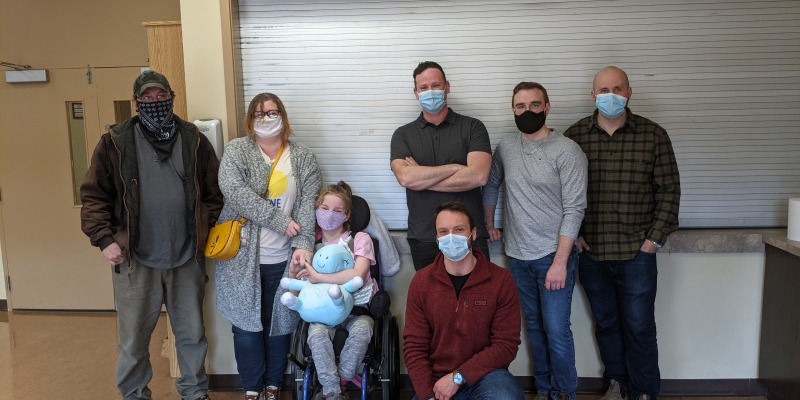Mechanical engineering group places second in national design competition, donates prize money

A group of mechanical engineering students is a winner in the national 2021 Innovative Designs for Accessibility (IDeA) competition.
Class of 2021 graduates Bradley Dawe, Jesse Rideout and Tyler Lundrigan, along with fifth-year student Ian Walsh have won second place in the Technological/Communication Barriers category.
The student design competition, held by Universities Canada on behalf of Employment and Social Development Canada, challenges students to use their creativity to develop innovative, cost-effective and practical solutions to accessibility-related issues resulting in communities that are more accessible for persons with disabilities.
Access to technology
In their final year, mechanical engineering students are tasked with a senior design project, called a capstone project.
The group further developed their 2021 capstone project, the damped medical arm brace, for submission to the IDeA competition.
The assistive device is intended to provide individuals with compromised motor skills the ability to interact with a tablet for learning and communication purposes.
It was originally designed for Oriana King, a young girl with athetoid cerebral palsy.
The project was identified through the Newfoundland and Labrador chapter of the Tetra Society, a national organization that produces assistive devices for people with disabilities to achieve independent and fulfilling lives.
Oriana relies on her family and caregivers to hold her arm against her wheelchair tray in order to use her tablet at home and in school.
“When we met with Oriana and held her arm against her wheelchair tray, a lot of the involuntary movements subsided,” said Mr. Rideout. “With the arm brace we are designing and testing, Oriana’s arm will be held in a position that will allow her to use her tablet independent of the direct assistance of others.”
Damped medical arm brace
The arm brace consists of a mounting frame that attaches to Oriana’s wheelchair, a damping mechanism to centralize her arm in a desired direction allowing for some rotation of her elbow, and an arm brace that attaches to the damping mechanism which Oriana’s arm straps into.
Mr. Dawe describes the brace as a “plug-and-play” device.
“The wheelchair’s arm rest is removed and the custom-made arm brace slides into the arm rest receptacle and is secured with pins,” he said.
This allows for easy installation and removal. A custom wheelchair tray is used along with an adjustable three-dimensional-printed tablet holder to provide stability to the technological device during use.”
For the team, the most special part of the project is breaking down barriers associated with access to technology.
“Although I am very excited about the competition, the most rewarding part of the project for me was creating a device that could actually help Oriana during our prototype tests,” said Mr. Lundrigan.
“Technology plays such a large role in everything we do daily, so much so that it is often taken for granted,” said Mr. Walsh. “We were able to use some of the things we learned in school and some of the resources available to us at Memorial to create a device that can help a young person living with motor difficulties learn and communicate.”
Dr. Dennis Peters, acting dean, Faculty of Engineering and Applied Science, is congratulating the students’ innovation.
“With their creativity and skills they are already becoming leaders in their field,” he said. “It is very rewarding to see their design helping to improve accessibility for Oriana.”
The team plans to conduct longer duration tests with the device and tweak any necessary changes needed. The team also plans to donate their prize money to the Newfoundland and Labrador chapter of the Tetra Society to help fund future similar projects.